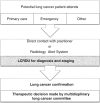Predicting delays in lung cancer diagnosis and staging
- PMID: 30605236
- PMCID: PMC6360216
- DOI: 10.1111/1759-7714.12950
Predicting delays in lung cancer diagnosis and staging
Abstract
Background: Despite growing interest in increasing the efficiency and speed of the diagnosis, staging, and treatment of lung cancer (LC), the interval from signs and symptoms to diagnosis and treatment remains longer than recommended. The aim of this study was to analyze the factors that cause delays in the LC diagnosis/staging process and, consequently, delays in making therapeutic decisions.
Methods: We analyzed audit data from a prospective dataset of 1330 patients assessed at The Lung Cancer Rapid Diagnostic Unit from 26 June 2013 to 26 March 2016. The number and type of procedures and medical tests and the times of all procedures were recorded. Clinical and epidemiological variables and whether the diagnosis was performed on an inpatient or outpatient basis were also recorded.
Results: Malignancy was confirmed in 737 (55.4%) of the 1330 patients, with LC in 627 of these (85.2%). The mean interval to final diagnosis was 19.8 ± 13.9 days. Variables significantly related to a longer diagnostic time were the number of days until computed tomography (CT) was performed (odds ratio [OR], 95% confidence interval [CI] 1.347, 1.103-1.645; P = 0.003), until a histology sample was obtained (OR 1.243, 95% CI1.062-1.454; P = 0.007), and the total number of tests performed during the diagnostic and staging process (OR 1.823, 95% CI 1.046-3.177; P = 0.03).
Conclusions: A greater number of tests and more days to CT and histology led to longer delay times. Optimization of these factors should reduce delays in the LC diagnosis process.
Keywords: Alert radiology system; delay; diagnosis; lung cancer; rapid lung cancer diagnostic unit.
© 2019 The Authors. Thoracic Cancer published by China Lung Oncology Group and John Wiley & Sons Australia, Ltd.
Figures
References
-
- Ferlay J, Soerjomataram I, Dikshit R et al Cancer incidence and mortality worldwide: Sources, methods and major patterns in GLOBOCAN 2012. Int J Cancer 2015; 136: E359–86. - PubMed
-
- Jemal A, Bray F, Center MM, Ferlay J, Ward E, Forman D. Global cancer statistics. Cancer J Clin 2011; 61: 69–90. - PubMed
-
- National Cancer Institute, Surveillance, Epidemiology, and End Results Program . Cancer Stat Facts: Cancer of the Lung and Bronchus [Cited 21 Feb 2018.] Available from URL: http://seer.cancer.gov/staffacts/html/lungb.html;2013
-
- Molina AJ, García‐Martínez L, Zapata‐Alvarado J, Alonso‐Orcajo N, Fernández‐Villa T, Martín V. Trends in lung cancer incidence in a healthcare area. Arch Bronconeumol 2015; 51: e53–5. - PubMed
-
- Santos‐Martínez MJ, Curull V, Blanco ML et al Lung cancer at a university hospital: Epidemiological and histological characteristics of a recent and a historical series. Arch Bronconeumol 2005; 41: 307–12. - PubMed
MeSH terms
LinkOut - more resources
Full Text Sources
Medical



